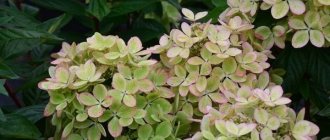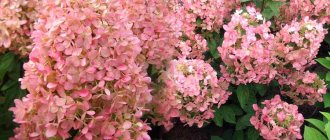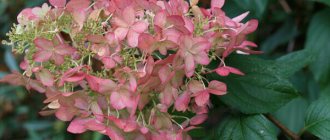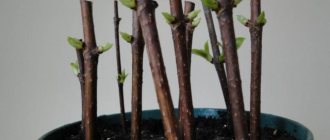Description of Limelight hydrangea
The description of the Hydrangea paniculata variety Limelight allows you to appreciate all its advantages. The shrub requires proper planting and care in the open ground, then it will delight the owners of the site with its flowering for a long time - from July to October.
Despite the fact that the variety is well known and has repeatedly received prizes at gardening exhibitions, beginning gardeners have many questions. What is the height of the plant on the trunk? Is it suitable for growing in central Russia? To understand which use in landscape design will be correct, it is worth studying in as much detail as possible all the intricacies of growing the magnificent Limelight hydrangea.
The main value of this variety lies in the presence of shoots, the strength and rigidity of which easily allows it to hold a huge number of inflorescences formed during the period of active flowering. It is this property that allows the paniculate Lime-Light hydrangea to maintain its decorative shape and extremely compact size.
Hydrangea paniculata blooms longer than other species of the genus.
Attention! Flower growers prefer this type of hydrangea for its fairly long flowering period, as well as for the presence of a truly unusual color.
According to its biological appearance, a variety of paniculate hydrangeas called Limelight, or, as it is also called, Little Light hydrangea, is a flowering deciduous shrub, the height of which can reach up to 2.5 m. The development and growth of hydrangea is extremely active, the annual growth is height can reach up to 25 cm.
The main feature of many paniculate hydrangeas is their spreading crown. By pruning it, the bush can be given a more decorative appearance.
The branches of the bush are straight in shape and have good rigidity, so during flowering there is no need to tie up the plant or provide it with any support. Lime hydrangea has dark brown shoots. The leaves are also dark green, slightly velvety and very pleasant to the touch. The green mass is quite thick, it is difficult to notice the shoots behind it. During the fall season, the leaves change color to purple tones. It is because of this feature that many people love Limelight so much.
History of selection
Arriving from Japan in the 19th century, paniculata hydrangea, or hydrangia, as its name is pronounced in Latin, quickly took root in the gardens of Europe. In the last century, Dutch breeders brought out a real treasure in the family of beautiful flowering shrubs - the Limelight hydrangea with strong shoots that confidently hold lush inflorescences. The variety was awarded prizes at various flower exhibitions.
Features of flowering hydrangea Limelight
The variety got its name from its bright green inflorescences. The color of the flowers changes over time from soft green to snow-white. At the end of the season, velvety pink flowers can be seen. Flower growers note another feature of growing hydrangea: the shrub has green inflorescences in the shade, white ones in the sun. But in general, hydrangea can tolerate shade quite well.
Hydrangea paniculata Limelight blooms almost all summer, until September. If planted in the right place, without access to wind, the plant will delight with beautiful flowers until mid-autumn. Lush greenish-white flowers effectively complement the green leaves, velvety to the touch. The bush is dense, the shoots are not visible at all. This makes it possible to use the variety in landscape design.
If the area of the plot does not allow, you can plant the hydrangea Hydrangea paniculata Limelight on a trunk. Breeders developed this miniature variety for small gardens. It grows to a height of only one meter. In beauty it is not inferior to the Limelight variety.
Hydrangea Limelight will become a beautiful hedge and decorate garden beds. Sometimes it is used for vertical gardening. This shrub also looks great with other ornamental plants. It is good to combine different types of hydrangeas of different colors. They perfectly complement plantings of irises, clematis and tree roses.
The flowering period of Limelight is July-September. In warmer climates, the plant is able to maintain its decorative qualities until the first frost. The inflorescences are large, 20-25 cm in diameter, cone-shaped, consisting of many small flowers. Immediately after the buds open, they have a predominantly green color with a lemon tint, which over time lightens to white, and in the fall it becomes pinkish.
The inflorescences of the variety are large, cone-shaped, and consist of many flowers.
Main characteristics of Limelight hydrangea
This unique culture is distinguished by a number of features.
A brief description of the Limelight hydrangea variety is as follows:
| The gentle name reflects the bright green color of the inflorescences, which is observed at the very beginning of the flowering process. |
| The foliage of this plant is no less picturesque than the original inflorescences. The blades, painted dark green, provide an effective color contrast with the delicate white of the inflorescences. |
| Over time, the color becomes soft lemon or white. An interesting pattern can be observed in this genus of flower: inflorescences that were grown in shady conditions acquire a greenish tint. |
| If a flower is planted in optimal conditions, providing reliable protection from wind and cold, it is able to delight with its beauty and grandeur until October, and this moment acts as a key advantage of this plant. |
| The hydrangea itself is a powerful bush that can reach up to 2 meters in height, while the flowering crown is also 2 m in diameter. |
| If you place the shrub in a substrate that is suitable for it and include a large amount of nutrients, growth can reach 30 cm per year. |
| The leaves are so dense that the shoots behind them are difficult to trace. In autumn, the leaves turn purple and change noticeably. |
Hydrangea Lime Light is resistant to temperature changes
Source
Frost resistance, drought resistance
Paniculate hydrangea can withstand frosts down to -29 °C. You need to take care of a cozy place, protected from the north wind and drafts. Then the plant will not be afraid of autumn temperature changes, and flowering will continue until October. Young bushes of the Limelight variety suffer from frost and must be covered. Just like adults, if the winters are snowless.
Hydrangea Limelight is moisture-loving, which is reflected in its Latin name, which comes from the Greek language (hydor - water). Water regularly. In the southern regions, if the plant is in the sun, the soil is mulched with a thick layer of grass. So the roots, which are located very close to the surface, protect from drying out until the next watering. In drought conditions, Hydrangea paniculata Limelight plants lose their splendor. Flowers become small.
Conditions for growing on a trunk
To grow hydrangea on a trunk, you need to take into account several parameters, which include lighting, temperature and humidity, and soil type.
Also find out how and when to replant a hydrangea to a new location.
Lighting
The shrub does not tolerate directly directed rays of the sun. It is best to plant the plant in areas where there is shade, and at midday the foliage does not suffer from sunlight.
Temperature and humidity
The plant is moisture-loving and does not tolerate dry soil. For this reason, lime hydrangea is planted in a place with moderate humidity. The optimal air temperature during the growing season is +22…+24°C. If it rises higher, it will be necessary to increase watering.
Pay attention to the information about why hydrangea blooms green.
The soil
Soils with a pH of 5 to 5.5 are considered ideal for planting and growing shrubs. On soils with a neutral pH (7.3), development will be slow, which may cause a lack of flowering. But you can always acidify the soil with peat.
Application in landscape design
Limelight is a universal variety. It looks equally impressive in single plantings in the middle of the lawn and in large tubs at least 80-90 cm wide, as well as in group plantings in hedges and borders. Used to decorate sunny meadows in forested areas and botanical gardens. It goes well with “colored” hydrangeas of other subspecies and ornamental shrub plants.
Limelight hydrangea is often used when planning green areas, both on your own personal plots and at government institutions. The most popular way to plant charming shrubs is along the fence between neighboring summer cottages. This is due to the fact that development regulations prohibit a continuous fence on the borders of neighboring estates. But since hydrangea has dense foliage and is not inferior in height to a fence, summer residents and gardeners began to survey the land with it.
When thinking about planting, professionals also take into account the density of foliage and the size of the inflorescences, which often leads to the following options for using these qualities:
- zoning of the territory, fencing off the resting place with bushes;
- longitudinal dense plantings along the edges of paths;
- symmetrical planting in front of the entrance group of villages or the gates of private courtyards.
Designers also fell in love with hydrangea because it requires annual pruning, that is, it can be cut into shapes, giving any geometry to the bush. This is especially important when the plant outlines the alleys - by trimming the bushes you can get a single green area, which will turn into a path of flowers of stunning beauty.
Bushes in standard form look very impressive, reminiscent of small tropical trees, or plantings of jasmine or white lilac, only with large tassels. It is difficult to form such a form on your own. It is easier to purchase hydrangea on a standard in a nursery or a reputable flower shop.
Source
Planting location and seed selection
Although Limelight hydrangea is considered a fairly unpretentious plant, it will not feel good everywhere. The site on which it is planted must meet certain requirements. The most important things for the development of hydrangea are:
- Soil composition;
- Lighting;
- Humidity.
Hydrangea of this variety should be planted on slightly acidic or acidic soils. On neutral soils the plant develops poorly. To improve the conditions for its existence, you can acidify the soil with peat. It does not tolerate alkaline soils; there is no point in planting them on them, as it will quickly die.
Hydrangea paniculata Limelight does not tolerate direct sunlight. It is better to choose a slightly shaded place for it so that the sun does not hit the leaves during the daytime.
Hydrangea paniculata Limelight loves moisture. Drying out the soil is detrimental to it. That is why a damp place is chosen for planting, but without stagnant water, since this also often leads to the death of the bush.
Hydrangea seedlings are planted in open ground and can be purchased at specialized nurseries. But you can grow seedlings yourself. For this you will need varietal seeds.
Hydrangea paniculata "Limelight" seeds cannot be collected from an adult flowering bush, even if it fully complies with varietal standards. Very often, seedlings grown from such seeds are completely different from the mother plant. Varietal seeds must be purchased from nurseries and garden centers. However, you need to ensure that they are stored for no more than a year before purchasing. Old seeds quickly lose their viability.
Seeds are sown in spring in a container filled with a mixture of peat and sand. They usually germinate in 1-1.5 months. Seedlings are grown in a container until 2-3 years of age. After this, they can be planted in the ground.
Propagation of the Limelight hydrangea variety
Propagation of this hydrangea variety is possible in only two ways.
Cuttings
Limelight hydrangea should be propagated using this method in June, or rather, closer to the middle of the month. To carry out the procedure of cuttings and cutting branches, it is better to choose this year’s shoots. They need to be cut into pieces that will have three leaf pairs. The lower pair will need to be removed, and the cuttings themselves will need to be soaked for some time in a solution of a root growth stimulator.
Shrub propagation
You can propagate hydrangea without causing damage to the bush using cuttings after pruning. To do this, the branches are cut in such a way that each cutting has 2 internodes. At the lower node, the leaf plates are removed and, dipped in Kornevin, they are planted in the ground in a shady place in the garden. In this case, you need to cover the cuttings with a jar, water them well with water, not allowing the soil to dry out. In about a month, the cuttings will have their own root system.
Features of planting paniculate hydrangea Limelight
Hydrangea paniculata prefers humus-rich, light, acidic soils. It’s great if there is a layer of loam underneath. It will retain moisture. Do not plant on calcareous soil.
Deadlines
Most often, plants grown in container nurseries that have a well-developed root system are planted. Such specimens can be planted all year round, except when the ground is frozen. Plants with bare roots (hedge shrubs) are planted only in autumn or early spring.
Bushes purchased from nurseries, wrapped in burlap, are good to plant in the fall. Usually they manage to take root before the onset of winter, and they enter the new season already rooted. This option is good because it helps to avoid the danger of drying out in the event of a hot, rain-poor spring and summer.
Selection and preparation of a site
Before preparing the soil for planting plants in open ground, it is necessary to remove weeds near the hole. Perennials such as wheatgrass, dandelion or plantain compete with the planted hydrangea for nutrition and moisture. If this is not done ahead of time, their roots will become intertwined, and it will be more difficult to get rid of the weeds.
The planting hole must be of an appropriate size - usually it is made twice as large as the plant's earthen ball. The top layer of soil is always more fertile than the bottom layer, which is devoid of many microelements. Therefore, the latter, consisting mainly of sand and clay, must be additionally fertilized.
If the excavated soil from the lower horizon is “empty”, sandy, through which water easily drains, it is made heavier and enriched. To do this, mix half and half with compost or fertile garden soil.
If, on the contrary, the soil is heavy and water stagnates in it, then it must be lightened. To do this, add river or coarse sifted sand. But it is better to use vermiculite or its analogues - this natural mineral does not cake, does not wash out, does not rot, does not decompose, and does not react with alkalis and soil acids. It is sterile, of no interest to microorganisms, mold and rodents, and contains no heavy metals or toxins. At the same time, vermiculite contains calcium, iron, aluminum, magnesium, which are so necessary for hydrangeas.
In the case of completely impermeable clay or silt soil, the bottom of the planting hole should be well loosened and mixed with sand or gravel. This action will allow at least partial removal of water from the planting hole, which otherwise will turn into a pot without drainage holes. If the soil is very dense, it would be a good idea to also loosen the walls of the planting hole.
Selection and preparation of planting material
Only healthy seedlings are selected for planting. Plants purchased externally can introduce dangerous diseases and pests into the area. The lush green color of the foliage and young shoots will tell you a lot about the condition of the hydrangea. If the greenery has dark spots, mold, strange growths, or, on the contrary, discolored areas, such a plant is most likely sick. If the roots are without soil, you need to inspect them for rot.
If the seedling is in a container, the plant is carefully removed so as not to damage the earthen ball with the root system. Hydrangea has thin roots, so they are easily damaged by mechanical stress. You should not forcefully remove the seedling from the container by its aerial part. A large package should be carefully cut, a small one should be poured with water, turned over and lightly tapped on the bottom.
If the roots are twisted and form a dense ball, the lower part must be cut off with pruning shears, and those that remain must be carefully straightened. This will make it easier for the roots to penetrate the soil.
Attention! It happens that the plant in the container is too dry. In this case, before planting, you need to soak the lump in a bucket of water for a few minutes so that it is well soaked. But this procedure does not replace subsequent watering after planting.
Landing technology
Having retreated at least 2-3 meters from the nearest tree, fence or wall of a building, dig a hole. It doesn’t matter whether a formed bush or a small cutting is planted, it must be of medium size in order to provide drainage. Usually a hole is made measuring 50x50x50 cm.
At the bottom, drainage is installed from scrap materials with a layer of 10-20 cm. Broken bricks and ceramics, coarse gravel and river pebbles are suitable, but it is better to put expanded clay or clay balls. Some gardeners use organic materials (peat, moss, sawdust) mixed with sand, but they will rot over time and moisture removal will deteriorate. Hydrangeas grow best in acidic soils, so it is useful to put acidic peat from high bogs on top of the drainage.
Next, the hole is half filled with the prepared substrate, the seedling is placed, the roots are straightened and sprinkled. Spill water (1-2 buckets are enough) and add soil again. Compact and water thoroughly again. If necessary, the seedling is tied to a peg driven nearby.
Important! The root collar should not be covered with soil after planting.
After watering, the hole is mulched. The protective layer protects shallow roots from drying out. It is useful to use pine sawdust, pine needles, and peat as mulch - these materials help acidify the soil.
Gardeners' opinion
After reading the photos and reviews, purchasing Limelight hydrangea, you can be sure that it will decorate the garden with its lush blooms. The main thing is to organize proper watering and fertilizing for it.
This variety of hydrangea has been growing on my site for 5 years. No diseases or pests were observed. The only thing is that I couldn’t find specialized fertilizers, so during flowering I feed it with flower fertilizer for budding.
Julia, Tula
Excellent Limelight variety. I planted it and it is growing for the second year without problems, the only thing is that it requires watering almost constantly in hot weather. But I have water nearby and therefore receive water without restrictions.
Svetlana, Zlynka
Hydrangea aftercare
There is little work involved in caring for a Limelight hydrangea.
Watering Limelight hydrangea
Hydrangea is a moisture-loving plant. Even its name speaks about this. Translated from Greek, the word Hydrangea means “vessel of water.” The soil must always be moist so that the bush is constantly blooming and beautiful.
Watering can be limited only if it rains frequently in the region. Loves hydrangea and a refreshing shower. Rare and small inflorescences will tell you that the plant lacks moisture.
Top dressing
Fertilizers suitable for all types of hydrangeas need to be applied once a month during the period of active growth. Do not neglect the instructions and dosages indicated on the packaging, as incorrectly applied substances can burn the roots and destroy the plant.
The Limelight variety is fertilized with special complex preparations: Green World, Pokon, Fertica, Valagro, diluted according to the instructions. Feed three times during the season.
Loosening and mulching the soil
Loosening of the tree trunk zone should be carried out regularly - about 4 times per season. Loosen the soil to a depth of about 6 cm. Organic fertilizers are applied a couple of times a season.
Mulching the soil helps keep it moist longer. It is recommended to use peat and fallen leaves, pine needles, bark, and wood chips as mulch. Mulch not only prevents the soil from drying out, but also stabilizes the acid level in the soil.
Before winter, it is necessary to carry out hilling to a height of up to 20 cm. Pour peat over the entire circle around the trunk. All shoots above the shelter must be trimmed. For shelter, you can use ordinary lutrasil, rolled in two layers, or greenhouse film. After covering, it is important to ensure that the process of rotting does not begin.
Pruning Limelight hydrangea
This is a mandatory event required to grow a beautiful and long-lived hydrangea bush. Pruning happens:
- formative. The process of forming the appearance of the future bush should begin in the spring, before the buds bloom. Last year's shoots remaining on the bush should not be touched when pruning, because future buds are located on them. The remaining branches are cut depending on their length: two-thirds of the longest ones and one-third of more modest sizes. It is also worth removing shoots located along the leaf crown to reduce density;
- sanitary The standard procedure required to increase the longevity and lifespan of lemon hydrangea. It is held in the autumn, around the beginning of November. When sanitary pruning, care should be taken to remove absolutely all dry and diseased shoots. The weakest branches are also pruned and successively cleared of old inflorescences;
- rejuvenating. Pruning necessary to bring old bushes into order. It is necessary to prune old branches, leaving 5-6 young shoots. They should also be shortened, leaving about five buds on them.
This variety requires regular pruning. Shoots in early spring must be shortened by 2/3 before sap flows in the plant. This will allow new shoots to begin to grow.
Autumn pruning is also necessary; during the fall, you need to cut off wilted inflorescences, as well as fragile and dry branches. This is necessary so that the bush does not get sick or weaken during the winter.
Decorative pruning is necessary for the correct formation of the bush. New flowers can only form on this year's shoots. Avoid cutting off too many shoots. Only old shrubs deserve rejuvenating (full) pruning.
Preventative treatments
In order for hydrangea to bloom all season long and delight you with its healthy appearance, you need to provide protection from pests and diseases. The shrub may suffer from pests that parasitize its leaves. Most often you can see spider mites, meadow bugs, snails and slugs on it. They do not allow the plant to develop normally and provoke the appearance of chlorosis. Preparations such as Karbofos, Actellik, Fitoverm help against insects. Slugs can be effectively destroyed with Meta.
Chlorosis is the most common disease of Limelight hydrangea. The shoots of the plant become brittle, the flowers become smaller and turn yellow. Powdery mildew also plagues hydrangeas of this variety. Oily spots appear on the leaves. It occurs due to high air humidity, and chlorosis due to excess lime in the soil. To prevent diseases, gardeners recommend fertilizing with iron salts. You can also use complex fertilizers that can balance the composition of the soil.
Source
Preparing for winter
Hydrangea paniculata Limelight is a fairly frost-resistant plant that can withstand severe frosts. However, young plants may still freeze a little. That is why it is necessary to cover bushes whose age does not exceed three years.
Attention! Before preparing the plant for winter, it should be hilled. After this, the area near the trunk of the bush is covered with a large layer of sawdust or dry leaves.
Limelight is well watered in October. Then the wide circle around the trunk is mulched with peat and humus, and later hilled up. Remove broken branches if preparing shelter for the winter.
Before covering the hydrangea for the winter, the branches of the bush are bent closer to the ground, and then fixed in this position. Once in this position, it is recommended to cover the plant with fallen leaves and cover it with roofing felt.
Sheltering shrubs for the winter
In areas of the middle climatic zone, Limelight hydrangea is covered with thick spunbond or burlap. Afterwards they throw snow towards the bush.
Wintering
The "Limelight" variety is frost-resistant and can withstand winter frosts in the middle zone. But in young specimens the branches may freeze slightly. This is undesirable, since if the shoots that grew last year freeze, the plant will not bloom. Therefore, bushes that have been growing in the garden for less than 3 years need to be covered for the winter.
Before sheltering young Limelight hydrangea paniculata bushes for the winter, they are sanitary pruned.
Then they are carefully hilled up, after which the tree trunk area is covered with a thick layer of sawdust and dry fallen leaves.
Bushes of the "Limelight" variety are quite tall, so usually their branches are bent to the ground before sheltering and securely fixed . The top of the bush is covered with fallen leaves and covered with spruce branches. It is covered with roofing felt on top. Small young bushes can be covered using a chain-link frame that is installed around the plant. The space between the frame and the plant is filled with dry leaves.
Adult plants do not need to be covered. The older the bush, the higher its frost resistance.
Diseases and pests
Limelight hydrangea is disease resistant. Sometimes the leaves turn yellow due to chlorosis, which develops in alkaline soil. The tree trunk circle is acidified with iron sulfate, citric acid, and mulched with pine needles. To protect the plant from leaf spot and powdery mildew, prevent it with fungicides Horus, Maxim, Skor.
Spider mites are controlled with acaricides. Against aphids and bugs, which also suck the juice from the leaves, spray with Fitoverm or insecticides Match, Enzhio, Aktara.
Attention! Hydrangea blooms profusely if the requirements are met: slightly acidic and moderately moist soil, warmth, partial shade.
Planting a plant in open ground
It is recommended to plant seedlings directly in a permanent place in the first ten days of May. It is better to wait until the night frosts are over. You shouldn't wait for hot weather either. Temperature changes can slow down the process of adaptation of the bush in a new place and slow down the growth process.
- First, a hole is dug for planting, which should not be too deep - no more than 40 - 45 cm, since hydrangea has a small root system. The width of the hole should be 50 - 60 cm.
- Then 20 liters of water are poured into the dug hole. Then you need to wait a day until the moisture is well absorbed into the ground.
- Before planting, the hole should be filled to one third with a mixture, which should consist of equal parts of humus, river sand, peat and ordinary soil. You also need to add a little superphosphate to the soil for each seedling.
- The young bush itself is planted together with a small lump of earth from the container so as not to damage the root system.
- After planting, the soil is lightly compacted around the bush. The root collar should remain above ground level.
- It is important to water the bush with one bucket of water. Place sawdust, straw or peat on top of the ground. This will maintain the required soil moisture and save the planted plant from overheating.
After planting a seedling, you need to learn how to properly care for it and provide comfortable conditions for its growth. Let's take a step-by-step look at what needs to be done.











